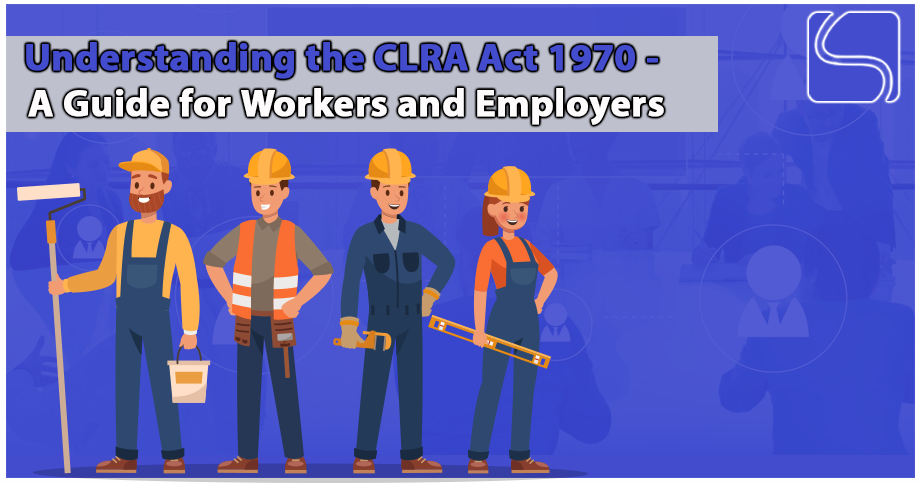Understanding the CLRA Act 1970 – A Guide for Workers and Employers

Shivam Narwal | Updated: Mar 13, 2023 | Category: CLRA License
The Contract Labour (Regulation and Abolition) Act, 1970 (CLRA Act) is a piece of legislation that regulates the working conditions of contract labourers in India. It is an important law that governs the relationship between employers and contract workers and provides a framework for ensuring their welfare and protection. In this blog, we will take a closer look at the CLRA Act 1970, its provisions, and what it means for workers and employers.
Table of Contents
What is the CLRA Act 1970?
The Contract Labour (Regulation and Abolition) Act, 1970[1] is a law that aims to regulate the employment of contract labour in certain establishments and provide for its abolition in certain circumstances. The Act defines a contract worker as any person who is employed on a contract basis, either directly or through a contractor, for any work of an establishment.
Who does the CLRA Act apply to?
The CLRA Act applies to all establishments that employ 20 or more contract workers on any day in the preceding 12 months. It also applies to establishments that are engaged in any of the following activities:
- Building and construction work.
- Stone breaking and stone crushing.
- Loading and unloading of goods.
- Manufacturing and processing of goods.
Key Provisions of the CLRA Act 1970
The CLRA Act has several provisions that aim to regulate the employment of contract labourers and ensure their welfare and protection. Some of the key provisions are:
Registration of Establishments: All establishments that employ contract workers are required to register themselves with the appropriate authority under the Act. The registration process involves providing details about the establishment and the nature of work being carried out.
Licensing of Contractors: Contractors who supply contract labour to establishments are required to obtain a license from the appropriate authority under the Act. The licensing process involves providing details about the contractor, the establishment they supply labour to, and the number of contract workers being supplied.
Welfare Measures: The Act requires employers to provide certain welfare measures to contract workers, including:
- Drinking water
- Latrines and urinals
- Washing facilities
- First aid facilities
- Canteens (if there are more than 100 contract workers employed)
Working Hours: Contract workers are entitled to the same working hours as regular workers in an establishment. They are also entitled to overtime pay if they work beyond the normal working hours.
Payment of Wages: The Act requires employers to pay contract workers the same wages as regular workers in an establishment for doing the same work. Contract workers are also entitled to receive their wages on time and in the prescribed manner.
What are the benefits of the CLRA Act 1970?
The CLRA Act has several benefits for workers and employers, including:
Benefits for Workers:
- Protection from exploitation and unfair treatment
- Access to welfare measures such as drinking water, washing facilities, and first aid
- Entitlement to the same working hours and wages as regular workers
- Entitlement to overtime pay for working beyond normal working hours
Benefits for Employers:
- Increased productivity and efficiency due to better working conditions for contract workers
- Reduced risk of legal disputes and penalties for non-compliance with the Act
- Greater accountability and transparency in the employment of contract labour
Challenges with the Implementation of the CLRA Act 1970
While the CLRA Act has several provisions that aim to protect the welfare of contract workers, its implementation has been challenging due to several factors, including:
- Lack of awareness and understanding of the Act among workers and employers.
- Limited resources and capacity of enforcement agencies to monitor compliance.
- Non-compliance by some employers and contractors who may try to circumvent the Act by employing contract workers through intermediaries or sub-contractors.
- The complex nature of certain industries, such as construction, where multiple contractors and sub-contractors may be involved in a single project.
These challenges have led to instances of exploitation and unfair treatment of contract workers, despite the existence of the CLRA Act.
What can be done to improve the implementation of the CLRA Act 1970?
To improve the implementation of the CLRA Act and ensure better protection for contract workers, several steps can be taken, including:
- Increasing awareness and understanding of the Act among workers and employers through training and education programs.
- Strengthening the capacity of enforcement agencies to monitor compliance and take action against non-compliance.
- Imposing stricter penalties and fines for non-compliance with the Act to deter employers and contractors from exploiting contract workers.
- Encouraging the use of digital technology to monitor the employment of contract workers and ensure compliance with the Act.
- Improving the working conditions of contract workers through the provision of better facilities and amenities.
Abolition of Contract Labour under the CLRA Act 1970
One of the key objectives of the CLRA Act is the abolition of contract labour in certain circumstances. The Act provides for the abolition of contract labour in any establishment where the work being carried out is perennial in nature and requires the employment of workers on a regular basis. In such cases, the Act requires employers to replace contract labour with regular workers.
However, the Act also recognizes that in certain circumstances, the employment of contract labour may be necessary. For instance, in industries where the demand for labour is seasonal, or in cases where the work being carried out is of a specialized nature that requires the employment of skilled workers on a temporary basis.
Penalties for Non-Compliance with the CLRA Act 1970
The CLRA Act provides for penalties and fines for non-compliance with its provisions. Employers and contractors who violate the Act can be fined up to Rs. 10,000 or imprisoned for up to three months, or both. Repeat offenders can face more severe penalties, including higher fines and longer prison sentences.
In addition to penalties and fines, the Act also empowers enforcement agencies to take action against non-compliant employers and contractors. Such actions may include the cancellation of licenses or registration, the closure of establishments, or the imposition of other penalties deemed appropriate.
The Role of Trade Unions in the Implementation of the CLRA Act 1970
Trade unions play a critical role in the implementation of the CLRA Act. They are responsible for advocating for the rights of contract workers, raising awareness about the Act among workers, and ensuring that employers and contractors comply with its provisions.
Trade unions can also play an important role in negotiating better working conditions and wages for contract workers. They can advocate for the inclusion of welfare measures such as housing, medical facilities, and education for contract workers and their families.
Conclusion
The CLRA Act 1970 is an important piece of legislation that regulates the working conditions of contract labourers in India. It aims to protect the welfare of contract workers and ensure that they are treated fairly and with dignity in the workplace. However, the implementation of the Act has been challenging, and there have been instances of non-compliance and exploitation of contract workers.
To improve the implementation of the Act, it is essential to increase awareness and understanding, strengthen the capacity of enforcement agencies, impose stricter penalties for non-compliance, and improve the working conditions of contract workers. The role of trade unions in advocating for the rights of contract workers cannot be overstated, and their involvement is essential for the effective implementation of the Act.
By taking these steps, we can ensure that the CLRA Act achieves its objectives and that contract workers in India are protected, respected, and treated fairly in the workplace.
Read our Article:Key Components of CLRA License: A Comprehensive Overview












